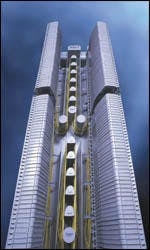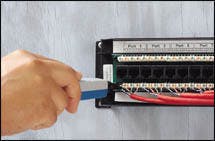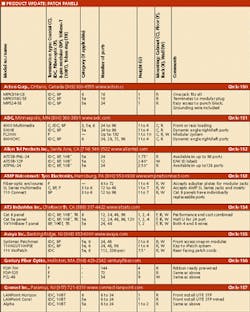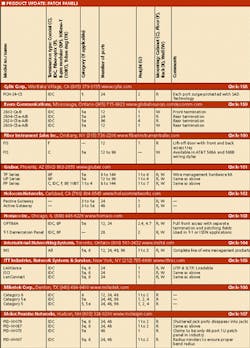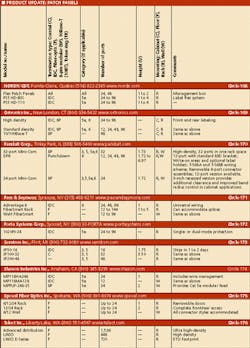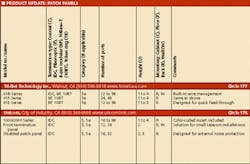Patch panels: network necessities
There are many things in this world that just would not be complete without a critical component. An Oreo without the cream filling is merely two unexciting chocolate wafers. While not as tasty, cabling systems are not all that different from an Oreo. If a key component is missing, then the data being transmitted cannot arrive to its destination, resulting in many unhappy customers. Patch panels are the "cream filling" of today's cabling systems.
You've got nerve
Patch panels (see table, page 86) serve as the nerve center for the cabling network. Simply put, according to Salvador Lara, marketing communications manager for Unicom Electric (www.unicomlink.com), the patch panel is "where all the horizontal cabling in the infrastructure is consolidated." Patch panels let you terminate cable elements and connect the signal (via a patch cord) to its final destination.
"Patch panels form the main link to collect data, and route it to where it needs to go," explains Douglas Peck, vice president of operations for Allen Tel Products (www.allentel.com). Patch panels are critical, and if a malfunction occurs, it can cause the whole system to fail. Joe Craig, general manager for Allen Tel, describes patch panels as "an enhancement to the entire communications system."
Often found in a building's telecommunications closet, patch panels serve a central role in the administration of the telecommunications network. "They provide ease of administration," says Lara, by enabling the process of moves, adds, and changes (MACs) in complex spaces. In today's complex office architecture, patch panels represent "the only way to transfer lines from one office to the next," says Craig.
For example, if two workers must transfer desk locations, a simple switch of patch cords into various ports on a patch panel can ease the move. Without this capability, much time and energy would be spent terminating cable that would have to be hard-wired.
MacPerfect
"Patch panels are instrumental regarding MACs in the closet of any wiring topology," explains Christopher Such, senior sales support for Gruber (www.gruber.com). The only time a patch panel would not be necessary, says Such, is at "Joe's Sandwich Shop." In other words, settings featuring home-run wiring running from the hub directly to the workstation. These settings do not require a patch panel because they do not need an intermediary point, and most likely will not accommodate any MACs going forward.
Copper vs. fiber
Patch panels are one of the few components used in both copper and fiber cabling networks. Some professionals are adamant that there is no real difference in the performance and construction, while others see a drastic differential between the copper and fiber products. Professionals concur, however, that the cost of fiber panels while having improved over the past year is far more than the copper equivalent. Such explains that the cost of actual installation is compatible but estimates a 30% to 40% per port premium for fiber panels.
Copper panels are typically constructed with 8-pin modular ports on one side and 110-insulation displacement connector (IDC) blocks on the other side. Wires come into the panel and are "punched down," or terminated, into the IDC block. On the opposite side of the panel is a patch cord, most often featuring an 8-pin modular connector, that plugs into the port corresponding to the wires terminated on the reverse side. The patch cord lets the signal be "patched" from one location to another.
Such is adamant that there is a "night and day difference between copper and fiber." He explains that with copper, each pair of wires has one port. Fiber requires two ports-one for the transmit end and one for the receiving end, because each tube of glass can only transmit in one direction. Fiber panels do not have any "real" patching, according to Lara, because the fiber is fed through a coupler and no hard-wiring is involved.
"Fiber is a lot simpler to install," says to Walt Takisaki, director of fiber optic product management for Telect (www. telect.com). The traditional fiber patch panel, according to Takisaki, typically features 72 or 96 ports. A high port count is required since two ports must accommodate each fiber cable.
There is no doubt that fiber is much faster than copper. But Peck identifies the main role of patch panels as "directing signal traffic" rather than moving the signal along at a certain speed. Both copper and fiber panels are governed by the same TIA/EIA standards required to produce speed and signal performance for the rest of the cabling network. "TIA/EIA is the highest level of criteria that products must perform to," says Such. "They must perform to be globally competitive." Patch panels must coerce data into performing up to the standards. Gruber claims to be able to enhance the signal through the use of proprietary wiring on the circuit boards.
Ports make the panel
Ports are one of the most important of patch panel components. These physical connection points provide a place for data to enter and exit the panel. The majority of copper panels have one wire terminated to an IDC block at the back of the panel, and then an 8-pin modular port on the front of the panel. Patch cords can then be easily placed into the ports.
Patch panels typically consist of four or eight modules of eight ports each, for a total of 24 or 48 ports respectively. But panels can consist of up to 96 ports and have been known to reach 336. Telect even offers a special patch panel featuring 1,536 ports for backbone fiber-optic cable. There is no physical limit to the number of ports possible on a panel, according to Peck. He says that "As long as there is room, you can go up and fill an 8-foot rack without interfering with the integrity of the panel."
It is no accident that ports are packaged in 8-port modules. "It is much easier to replace or fix the panel on a smaller scale," explains Lara. The fewer number of ports that must be replaced in the event of a malfunction means the fewer wires that must be terminated to the new module. This can make all the difference when a critical customer's network fails, such as that of a bank or brokerage house.
Cable management
The majority of manufacturers are making cable management a primary focus of new patch panel designs. Unicom's Lara points out that "Cable management is a detail most often missed when installing a patch panel." This has been a primary area of design focus for Unicom, he says, and the company recently introduced its front-access panel that lets all termination and cable management activity be conducted from the front. Available with either 12 or 24 ports, the front-termination patch panel can be a solution for installations where space is critical.
Gruber's TP Series of patch panels has wire management built in. Such explains that the only external wire management is for patch cords. The internal management is added onto the panels at no additional cost. Gruber is also working to overhaul its UP Series panels to include cable management and enhanced performance by the end of the third quarter of this year.
Installation process
There is no lack of industry opinion on the installation of patch panels. One camp, of which Takisaki is a member, believes that installing patch panels is fairly simple. "Running all the cable is more difficult than installing a patch panel. They are just bolted in," says Takisaki. Allen Tel Products concurs that patch panels are one of the easiest components to install, with the average 48 port panel taking less than an hour.
But some believe that installers must be carefully trained to install patch panels. "You must have a certain technique to properly install patch panels," says Lara. He finds that terminations are often too tight, causing the cable management to be less effective. Careful technique, in his opinion, makes all the difference in the time it takes to install a panel.
Takisaki says installers must be cautious when installing fiber panels. "If a technician moves the glass too much during installation, it can upset the signal of neighboring fibers." As traffic speeds increase, the impact of this disturbance increases. Additionally, he says installers must be conscious of the bend radius when connecting fiber-optic cable to the patch panel. The standards allow a maximum of 30 mm for bend radius. "You affect long-term viability of the fiber if it is bent more because light can leak out," explains Takisaki.
NORDX/CDT (www.nordx.com) has introduced a patch panel designed with the modules already loaded. Available this fall, the GigaFlex PS6+ will be loaded with either 110 or BIX blocks. Product manager Gaeten Prosper adds that the new panel will also offer "a rear cable management bar that can be placed at three different levels by the end-user to adapt to various needs."
What to look for
Prosper encourages installers to shop for a flexible patch panel. For ultimate usefulness, he advises that panels feature cable management bars, a designated space for labeling, and port count configuration flexibility. Labeling is critical, and Such maintains that "on the face of the panel, there should be a clear label. This is almost as important as the actual cable going into the panel."
When shopping for a panel, cost can become an intimidating factor, especially in the fiber realm. Takisaki notes that fiber patch panels can range from $300 for the simplest patch panel system with adapters, to $20 to $22 per port for a high-density, advanced distribution frame with exceptional cable management. The choice of panel, says Takisaki, must be made by weighing the cost of the patch panel versus the cost of potential network failure.
While highly functional, patch panels are rather stagnant products with little activity in the way of design modifications. The biggest development is the pending introduction of Category 6 panels. ADC (www.adc.com) and Molex (www.molex.com) are among the few that have already brought these products to market.
null
null
null
null

